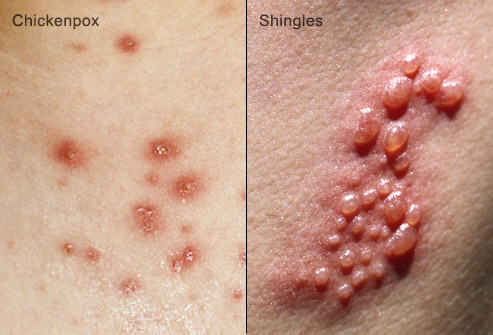At one point in time, it was believed that chickenpox and shingles were distinctly different diseases. Now it is known that they are both due to the Varicella zoster virus, a member of the herpes family of viruses. Herpes comes from the Greek term called "herpein", which means "to creep" and refers to the creeping pattern of the eruptions noted in shingles. What exactly is the relationship between chickenpox and shingles?

FAQs About Chickenpox and Shingles
1. What Are Chickenpox and Shingles? What Is Their Relationship?
Chickenpox is also known as the Varicella virus infection. It is a contagious disease caused by the Varicella-zoster virus and usually occurs in children. It gives kids itchy, red rashes that occur all over the body. If a child is not vaccinated against the virus, he or she will get the infection and will have a three-stage rash that starts with red bumps all over the body, then turns into blisters filled with fluid, eventually crusts over and forms scabs.
Shingles is also caused by the Varicella zoster virus, which is the identical virus that results in chickenpox. Anyone who has had the chickenpox infection is at risk of getting shingles. The virus harbors in the nerves of the spine and brain and can eventually break out in a specific body area. This is known as shingles.
No one knows the exact reason why the virus resurfaces. A person may have a poor immune system that allows the virus to resurface. Shingles is a relatively common disease in older people or in those who do not have a normal immune system. It begins with a burning pain or numbness and tingling in a certain body area. The rash and itching feeling start soon after that.
2. Are Both Chickenpox and Shingles Contagious?
Chickenpox is a very contagious disease that can easily be spread from one child to another. The individual with chickenpox is most contagious before the rash even shows up—about 2-5 days into the sickness. This means that the chickenpox virus can shed and infect others before you come down with the obvious signs of the illness. Chickenpox can be spread via sneezing or coughing, because droplets containing the virus can be spread from the mouth or nose of the infected person to someone who hasn't yet had the virus.
Shingles, on the other hand, is not contagious in the same way. You can't get the shingles virus when someone who has shingles sneezes or coughs. If you have had the chickenpox virus in the past, you won't catch it. Shingles is only contagious to those who haven't had the chickenpox. In this case, only close, personal contact with open sores from the shingles blisters directly can give you the chickenpox virus. You cannot get the shingles from an individual who has the shingles.
3. What Is the Best Way to Prevent Chickenpox and Shingles?
According to the CDC, you can prevent the chickenpox by getting two separate doses of the chickenpox vaccine. The vaccine is 98% effective in preventing chickenpox. It should be given to children, teens, and adults who have never had the chickenpox disease. Children should receive the vaccination at about 12 months of age and again right before kindergarten. Immunizations for chickenpox first became available in 1995; so many kids today never get the chickenpox.
A person can also get the shingles vaccination. This vaccination is recommended for those over the age of 60 years, because these are the ones most susceptible to getting shingles. The shingles vaccine can also be given to those who are between the ages of 50-59 years of age. Not many individuals get the shingles vaccination, but for those that do, it reduces the incidence of post-herpetic neuralgia, which is a chronic pain you can get after suffering from the shingles.
4. How to Treat Chickenpox and Shingles
Both chickenpox and shingles can be treated with home remedies and antiviral medication.
- For chickenpox, acyclovir is one kind of antiviral drugs used in adults who have the chickenpox because adults with chickenpox can be severe and get viral pneumonia, which can be prevented with this drug.
- For shingles, antiviral medications can be used to shorten the course of the disease. They must be taken soon after the onset of the blisters in order to be effective in controlling the disease. Antiviral medication includes Acyclovir, Valtrex, and Famvir. They are taken for a week in order to clear up the rash faster.
The other treatment options for chickenpox include acetaminophen for relieving the pain of the lesions. It is also a good idea to take frequent warm baths that contain oatmeal in them. Aveeno baths are also helpful to control the itching. You can also take calamine lotion to help the blisters dry out quickly and to soothe the damaged skin. Benadryl can be taken for itching and to help the child sleep better. Small kids might have to wear mittens to avoid scratching the blisters, which can result in a bacterial infection. Trim the nails short, so when you itch, you won't open up the blisters.
For treating shingles, the options help the lesions heal faster and lessen both the discomfort and pain associated with shingles. Tylenol can help with the discomfort. You can also use home remedies. For instance, you can apply cold compresses made with Burrow's solution and take cool baths to decrease the pain. Try not to break the blisters as this can pass along the infection to others. Patients with shingles should use gauze to cover the lesions and should wear loose clothing so they don't get too warm.
